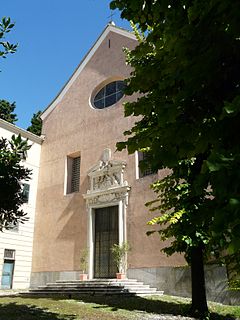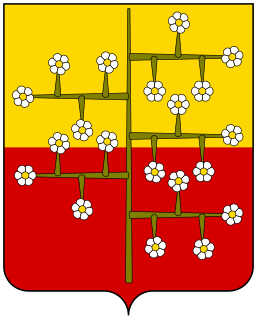The primary languages of Calabria are the standard Italian language as well as regional varieties of the Neapolitan and Sicilian languages, all collectively known as Calabrian. In addition, there are 100,000 Arbëresh-Albanian speakers, as well as small numbers of Calabrian Greek speakers and pockets of Occitan.

Brianza is a geographical, historical and cultural area of Italy, at the foot of the Alps, in the North-West of Lombardy, between Milan and Lake Como.

Margaritus of Brindisi, called "the new Neptune", was the last great ammiratus ammiratorum of Sicily. Following in the footsteps of Christodulus, George of Antioch, and Maio of Bari, Margaritus led the fleets of the kingdom in the reigns of William II (1166–1189) and Tancred (1189–1194). He probably began as a Greek pirate and gradually rose to the rank of privateer before becoming a permanent admiral of the navy. In 1185, he became the first count palatine of Cephalonia and Zakynthos. In 1192, he became the first count of Malta. He also held the titles of Prince of Taranto and Duke of Durazzo.

Giovanni Bernardo De Rossi was an Italian Christian Hebraist. He studied in Ivrea and Turin. In October 1769, he was appointed professor of Oriental languages at the University of Parma, where he spent the rest of his life. His inaugural lecture on the causes of the neglect of Hebrew study was published in 1769 at Turin.

Carlo Giuseppe Ratti (1737–1795) was an Italian art biographer and painter of the late-Baroque period. He was a pupil of the painter Giovanni Agostino Ratti. Born in Savona, he moved to Rome where he befriended Anton Raphael Mengs and Pompeo Batoni. He died in Genoa, where he labored for many years.
RaffaelloGestro was an Italian entomologist who specialised in Coleoptera. Gestro was the Director of the Natural History Museum of Giacomo Doria Genoa where his collection is conserved. He was a Member and President of the Italian Entomological Society.

The Delle Piane family is an old Genoese noble family first recorded in Polcevera in 1121. Over the past ten centuries it has produced many distinguished government officials, clerics, diplomats, soldiers and patrons.

Francesco Panigarola was an Italian Franciscan preacher and controversialist, and Bishop of Asti.

Carlo Ilarione Petitti count of Roreto was an Italian economist, academic, writer, counsellor of state, and senator of the Kingdom of Sardinia. He is seen as a prominent figure in the Italian Risorgimento.

Federico Chabod or Frédéric Chabod was an Italian historian and politician.

The Battle of Settepozzi was fought in the first half of 1263 off the island of Settepozzi between a Genoese–Byzantine fleet and a smaller Venetian fleet.

The Church of Saint Anne, with the adjacent convent and pharmacy of the Discalced Carmelites, is a Roman Catholic church located in the residential quarter of Castelletto in Genoa, Liguria, north-western Italy. The village - now surrounded by the city - is still intact, with its leafy trees, cobbled walkways and open views from Salita Bachernia over the Gulf of Genoa, the harbor and the Old City.
The Annales Cavenses are a chronicle compiled at the La Trinità della Cava abbey in Cava de' Tirreni, province of Salerno, southern Italy. It consists of annalistic entries spanning the years 568 to 1318, i.e. essentially the entire duration of the Middle Ages in Italy.
The Catalogus Baronum is a collection of registers of the military obligations owed by the barons of the Kingdom of Sicily. The collection was compiled in 1322 under the Angevin dynasty. It contains three distinct registers from distinct periods and covering different regions of the kingdom. The first, the Quaternus magne expeditionis, was originally compiled under the Norman king Roger II in 1150–51, then revised by his grandson, William II, in 1167–68. It listed the fiefs of the crown in the Principality of Capua, the Duchy of Apulia and the Abruzzi and detailed the services each owed. The second register was composed under William around 1175. It lists only the knights of Aquino, Arce and Sora. The third register, the Pheudatarii iusticiaratus Capitanatae, is that of the Swabian king Frederick II from 1239–40. It lists only the feudatories of the Capitanate.

The Battle of Trapani took place in 1266 off Trapani, Sicily, between the fleets of the Republic of Genoa and the Republic of Venice, as part of the War of Saint Sabas (1256–1270). During this conflict, the Venetians had held the upper hand in naval confrontations, forcing the Genoese to resort to commerce raiding and avoid fleet battles.

The Battle of Saseno took place on 14 August 1264 near Saseno island off the coast of Albania, between a fleet of the Republic of Genoa and a trade convoy of the Republic of Venice, during the War of Saint Sabas. So far in the war, the Genoese had experienced only defeats in direct confrontations with the Venetian navy, and had therefore resorted to raiding the Venetian commerce convoys to the Levant, which were critical to the Venetian economy.

Conrad Malaspina, also known as L’Antico or The Old was an Italian nobleman who lived in the 12th century. There is no certainty about Conrad's birthdate but most historians agree that it is around 1180, his death date is also uncertain but it is speculated to be around July 1254. Conrad was the forefather of the "Spino Secco" branch of the Malaspina family. Conrad Malaspina's achievements were of fundamental importance for the way Italian territories were shaped. He had very close relationships with Emperor Frederick II as well as many intellectuals and political figures of the time.

Corrado Malaspina, was an Italian nobleman and landowner.

Opizzo Malaspina known as Opizzino was the forefather of the Spino Fiorito branch of the Malaspina Family.
Gioacchino Di Marzo was an Italian art historian, librarian and Jesuit. He was librarian to the Comunale di Palermo as well as a historiographer and one of the founders of modern Sicilian art history.